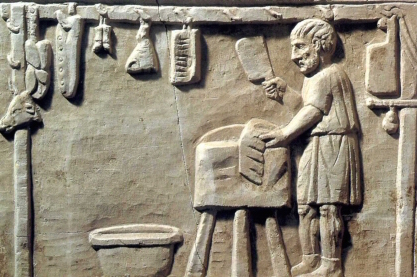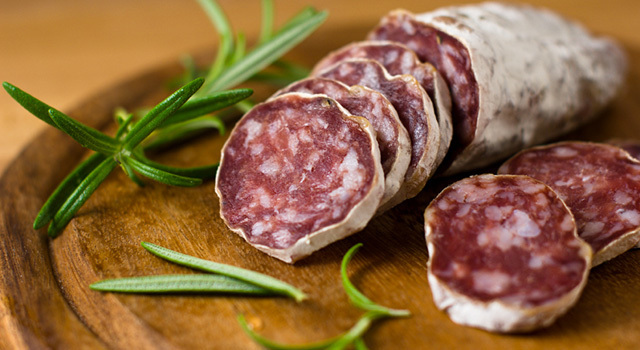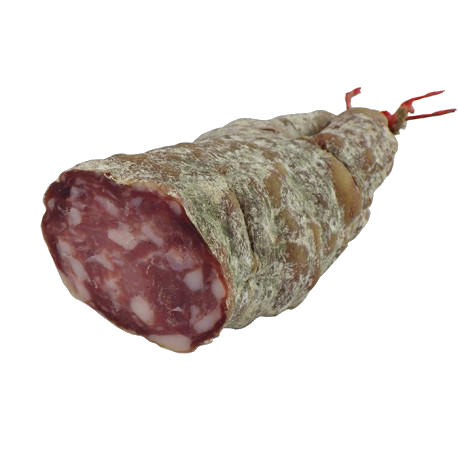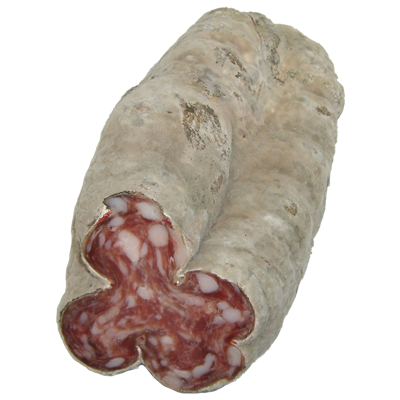HISTORY
For more than 2,000 years, saucisson sec has been hugely popular and nothing much has really changed in the way they are made today.
It is thought that Latin meat seasoners shared their knife skills and know-how with Gaul breeders, who in turn provided flavoursome meat from their magnificent pigs raised in the great outdoors and fed on acorns…
Also, at the time, the pigs considered to be such a delicacy by the Romans were imported from what was then Gaul (western Europe encompassing France, Belgium, Luxembourg, Switzerland and Germany). That’s team work!
Specialist pork butchers already existed in Rome, where they worked alongside beef specialists. These were further specialised into salsamentarii (salted meat merchants) and botularii (black pudding and sausage sellers). Many pork-based charcuterie names both in French and English derive from the latin; the term ‘sausage’ for example stems from the latin salsus, as does the French saucisson or saucisse.

Back in ancient times, the size of the sausage was determined by the skins, which were prepared from sheep or beef guts. Pendulus, a large sausage, was made using pig’s cecum, the first part of the large intestine, while hilla, a very thin sausage, was made with casings from the small intestine, like the dry-cured sausage found in mountain areas of France. In the area known as Cisalpine Gaul, now part of Italy, tuccetini, a sausage prepared from a blend of pork fillet and beef is similar to the Jesus sausage still commercialised today (French: Jesus sec).
And it is no coincidence that the regions of France known for their cured meats, were often urban areas with strong Roman origins, such as Lyon, Arles and the Ardennes.
In the 13th century, the salt-pork creativity of the chaircuitiers was so prolific, dried sausages in particular, that the authorities were forced to intervene and legislate that only ‘salt, fennel and other quality spices’ could be used in their production.
THE ART OF PRODUCTION
Saucissons secs are made from a meat mixture – around ¾ lean meat and the rest fat – ground to different consistencies from fine to coarse, salted (to preserve the meat), seasoned and filled in casings. The sausages are then carefully dried. They require no cooking and so are ready-to-eat.
There are two large ‘families’ of dry-cured sausage: the medium to coarse varieties, which are the most commonly found saucisson sec in France, such as saucisson de montagne, rosette, pavé and Jesus, and the more fine-grained types such as Danish salami.

Sausages are considered to be coarsely-grained when the diameter of the pieces of meat is at least 6mm across.
As a rule of thumb, saucisson dried sausages tend to be larger than their smaller, thinner saucisse variants.
In the vast majority of cases, dry-cured sausage is prepared with lean sow’s meat (older pigs tend to be tastier) and/or trimmed and denerved pork meat, pork fat and a skin prepared from animal guts. Sausages made from beef, donkey, horse, mule and goat’s meat can also be found. Dry-cured sausage also contains salt – 25-35g/kg for smaller sausages and 35g/kg for larger examples – which preserves the meat and enhances the flavours.
Depending on the recipe, other ingredients may include sugar, flavourings, pepper and sometimes green pepper, spices (cardamom, clove, chilli, nutmeg and garlic), wine or alcohol*. More often than not, yeasts form an integral part of the recipe, since they start off and determine the ageing-process of the sausage.
The casings or skins are either natural, made from animal intestines, or synthetic.
The choice of which skins to use is a key stage in the process. The skins must be sufficiently thick and strong to withstand the filling process, and yet thin and permeable enough to allow the meat to breathe and dry in optimum conditions.
Meat filling or ‘paste’ is ‘pushed’ either into skins from the pig’s large intestine, used to make domestic dry-cured sausage and saucisson de montagne, the cecum (the first part of the large intestine used to make Jesus saucisson), or even from the small intestine which is much smaller in diameter and used for thinner, dried sausages.
The dusty white coating on the outside of the saucisson is known as fleur, or flora, flower or bloom. This either develops naturally or results from inoculation with micro-organisms to boost the ageing process and enhance flavour and aesthetics. This stage is strictly controlled throughout the production process.
Drying and maturing takes place in temperature-controlled conditions, where the average temperature is 12-14°C, and lasts 4 to 10 weeks depending on the thickness of the sausage.
Did you know ?
People often say that dry-cured sausages are saltier now than they used to be. That’s just a fallacy and only an impression. In fact, over the past twenty-five years and in line with consumer needs, sausage makers have worked hard to significantly reduce the amount of salt in sausages, while at the same time ensuring the end result is less-fatty and more succulent.
These slight adaptations to the recipe have led to changes in taste; while fat reduces our perception of saltiness; meat, in contrast, because of its protein content, enhances the salt.
Discover more about how dry-cured sausages are made in the video below:
Each dry-cured sausage is different
Saucisson de montagne
Saucissons secs from the mountainous areas of France are 100% pork, coarsely-ground, and made exclusively from casings prepared from the large intestine. While in the past, all coarsely-ground saucisson produced in mountainous regions were allowed to use the name Saucisson de montagne, nowadays, the designation is strictly regulated; the dry-cured sausage must be made in areas defined as mountainous and prepared using meat sourced from animals raised in mountainous areas.

Saucisson sec de montagne
Saucisse seche
Dry sausages are made from fresh, firm meat, ideally from denerved and salted sow’s for a tastier sausage. It is similar to dried meat products whose meat filling has usually been coarsely chopped and filled in slender skins made from pig’s small intestine, 30-40mm in diameter. The period of drying/ageing is quite short (3-4 weeks) and takes place in a humid, cold, yet not bitingly cold environment. There are many different varieties to look out for: saucisse seche d’Auvergne (sausage area extraordinaire), and from Lorraine, Ardeche, Savoie and the Black Mountains in the Tarn (Montagne Noire).
In Auvergne, saucisse seche is filled in a slim, natural gut casing, tied with string and bent like a horse shoe. It is not smoked.
Saucisse à la perche looks like a slim, long cylindrical tube, wrapped around a wooden pole.
Saucisson de menage, also sold as saucisson sec, is the most commonly found example. The meat mixture is medium-ground, filled in large intestines, and weighs at least 200g. It is always ‘pur porc’ ie. 100% pork.
La rosette or fuseau
Due to its size, the ‘small pink sausage’ is the largest dry-cured sausage of all. It ranges in weight from 300g to more than 1kg and is produced across France.
The names are a catch-all for any dry-cured sausages which are truncated or spindle-like in shape. The distinguishing feature of rosette is its coarsely-ground meat which is always 100% pork. It is stuffed in ‘fuseau’ casings, which form part of the pig’s intestine commonly known as ‘rosette’ due to its pink colour, hence the name. It is then tied at both ends and wrapped in a plastic outer layer. The very thick casing gives the sausage its characteristic flavour. Aficionados particularly appreciate the sausage’s delicate hint of acidity.

Jésus sec
Pavé, miche, galet or rouelle
All these names refer to a pure pork sausage which is slightly flattened in shape and longer, and more than 70mm in diameter. It can also be rounded in shape like a small camembert. Pig’s intestines are filled with the meat filling, which is similar to Rosette or mountain sausage. This type of saucisson is more often than not covered in black pepper and sometimes Provence herbs.
Jesus sec
With its generous 10cm girth, the outer casing is sourced from the cecum, the first part of the large intestine. Jesus sausage, which is produced across the whole of France, is always made from 100% pork and medium-ground. In composition it is very similar to Rosette, and its colour on the outside is brown. In the past, Jesus sausage was a product of great social standing, and enjoyed on special occasions only. Some say that the term ‘Jesus’ stems from the fact that the saucisson was produced in the winter months and traditionally eaten at Christmas. Others believe the name derives from its appearance, swaddled like a new-born baby.
Finely-ground saucisson
Salami is a prime example, and France’s most popular variety is Danish-style salami. It can also be produced in France.
Salami
Salami is a dry-cured sausage made from 100% pork, or pork and beef, which is slightly smoked, finely-ground and large in size. It is characterised by small, highly-visible flecks of fat evenly distributed throughout the meat. In some regions in eastern France, Germany and Italy, the term ‘salami’ is a catch-all term to describe all dried-sausage.
SPECIALITIES
Saucisson de Lyon
One of the very first known recipes for Lyon dried-sausage was recorded in 1839, by Maurice Cousin in his work Neophysiologie du gout. While in the past, the dried-sausage was made from beef, today it is made from pure pork, from very finely-ground lean meat.
The distinguishing characteristic of this sausage is the small lardons visible in the filling and the meat’s distinctive deep-red colour.
This Lyon speciality, with its very distinctive and unique appearance, succulent texture and unusual flavour, is little known beyond its region of production.
Lean meat is usually sourced from pork shoulder and ham, preferably dark in colour, and the fat must be sourced from hard back fat.
Once finely ground, the lean meat is salted and allowed to rest for 24 hours at a constant temperature of 0C. Meanwhile the back fat is chopped into small cubes (lardons), salted and also left to rest for the same period.
The resting period is crucial to give the meat time to fully absorb the salt. The technique also prevents the lardons clumping together once mixed with the meat. The two meats are then combined and seasoned. This sausage also stands apart for its unusual casing; the meat is encased in a double-skinned natural casing specially made for this particular saucisson. The process requires a very specific know-how to retain all its flavour yet still lose weight as it dries. The double skin is made on a mould using pig’s small intestine covered in large intestine, and once dry, the two skins will stick together. Once filled, the saucissons are dried at 10-12C for 4-7 weeks, depending on their size and the ageing process.
Saucisse seche à la perche
The distinguishing feature of this sausage is the drying process, where the long sausage is draped over a wooden pole or ‘perch’. It is only produced in an area stretching from the Monts de Lacaune mountain region in the north-eastern Tarn to the north of Aveyron, towards Laguiole.
26-28mm in diameter, this coarsely-ground, long sausage, is formed of a series of long loops. The number of loops may vary, which largely depends on the length of the casing prepared from pig’s small intestine. The meat filling is dark red in appearance and visible through the casing.
Lean shoulder meat and pork belly are combined with hard fat and ground (more finely in the Tarn than in Aveyron), seasoned with salt and pepper, then stuffed in casings. Finally, the sausages are draped over the poles allowing around 30cm for each loop. The sausages are then lightly steamed for 24 hours at 20C maximum, before being dried for 10-15 days in the drying unit at 13C, with average humidity to restrict the amount of flora on the exterior (penicillium and yeast).
In Aveyron, the sausage is washed and brushed to remove any traces of flora, while in contrast, in Monts de Lacaune, the exterior retains its dusty white bloom.
The history of saucisse à la perche dates back at least to the beginning of the century. Back then, the sausage was draped over a chestnut wood perch.
Saucisson de Lacaune PGI
Saucisse and the larger saucisson from Lacaune are essentially the same sausage made from the finest pork cuts, which are coarsely-ground and protected inside a natural gut casing. The perfect balance of pork fat and lean meat, their typical character shines through.
The drying period varies depending on the size of the sausage, varying from at least 2 weeks for dry sausages and 3 weeks for saucissons.
The texture is soft and firm with a moderately salty flavour. The sausages have an aroma and flavour typical of dried and matured meat, with a pronounced peppery note. Simply flavoured and of moderate intensity, with only a slight fatty flavour.
For more information: www.salaisons-lacaune.fr
Saucisson d’Arles
A finely-ground sausage meat made from pork fat, and unusually, from lean beef or rarely from horse meat (donkey, mule or horse). The saucisson is flavoured with Provence herbs and filled in beef casings. Having been allowed to dry for six weeks, it is slightly softer in texture when eaten. Once prepared from Camargue bulls, it is said that saucisson d’Arles was particularly appreciated by good King Rene (1409-1480). Nowadays saucisson d’Arles can be made across France.
Salamu aka salcicciu, salciccia or Corsican saucisson
This is a very thin, dried sausage, made from coarsely chopped lean pork and very little fat, seasoned with salt and pepper.
Its distinguishing characteristic is the long ageing process, which varies from 3 months for the smaller examples and 10 months for the larger examples. The first 3 months are spent in a drying unit, then if required, the sausages are transferred to a cool cellar.
Salamu is made using larger, thicker casings (and also goes by the name of minuccui cularinu or rosette) or stuffed in x in which case known as cecu or cioncciula, yielding a similar sausage to Jesus. There’s plenty of evidence to suggest that the term salamu means ‘large dried-sausage’ in Corsica.
However, as is the case with many products from family charcuterie tradition, there are few traces in ancient documents.
Salami de Strasbourg or Salami alsacien
This pure pork, fine-grained dried sausage, where small flecks of fat are evenly spread throughout the meat.
This type of salami from Eastern France is always smoked.
Not forgetting many other varieties of dried sausage from Auvergne and Savoie…
Saucisson de montagne, saucisse sèche, rosette, fuseau, pavé, miche, galet, jésus and salami… France is crazy about ready-to-eat dried sausage!
Saucisson production is concentrated around central France, Rhone-Alpes, and broadly speaking in mountain regions where the cool, dry climate allows production all-year round.
[vc_row][vc_column][vc_single_image image=”2103″ img_size=”full” alignment=”center” onclick=”custom_link” link=”https://www.lescharcuteries.fr/wp-content/uploads/2017/08/saucisses_et_saucissons_sec_complete.png”][/vc_column][/vc_row]
NUTRITION
Why is dried sausage so rich in proteins?
Drying is a process that concentrates the nutritional values and as a result increases nutrient content. Dried sausage makes a great snack to stave hunger.
Protein-rich foods such as dried-sausage have a satiating effect and will keep you feeling full for longer. A protein powerhouse like saucisson provided a feeling of well-being and will keep you energised throughout the day.
Dried sausage also contains vitamin B – great for energy levels – especially B1, B6 and B12. These vitamins play an important role in supporting the nervous system and red blood cells (B6 and B12).
Dried sausage is also a good source of iron, usually heme iron, which is more easily absorbed by the body. 100g of dried sausage contains on average 1.27mg of iron.
| Protein g/100g | Fat g/100g | Carbohydrate g/100g | Salt g/100g | Energy kcal/100g | |
|---|---|---|---|---|---|
| Pure pork dried sausage/ saucisson sec | 24,3 | 34,5 | 2,41 | 2,42 | 418 |
| Rosette, Jesus and fuseau | 26 | 31 | 0.7 | 4.8 | 384 |
| Pure pork dried sausage/ saucisse seche | 27 | 37 | 1.2 | 5.1 | 442 |
| Chorizo | 21 | 42 | 1.8 | 5.0 | 465 |
| Salami | 18 | 39 | 1.1 | 3.5 | 425 |
Source : Ciqual 2016
